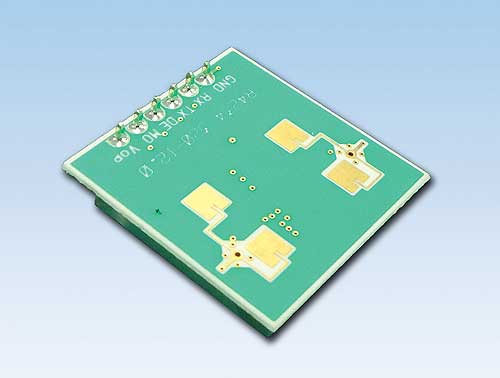The Doppler sensor uses a transmitter antenna to emit microwaves at a specific frequency and a receiver antenna to receive the waves reflected from the moving object. As a result of the Doppler effect, the movement of the reflecting object causes the frequency of the reflected wave to change, and this is evaluated in the sensor.
FSK Doppler uses two different frequencies for the emitted wave, which are emitted alternately at a pre-defined time interval. Here, too, the Doppler frequency is proportional to the speed of the moving object. The two different frequencies generate two different Doppler frequencies characterized by a phase shift. This phase shift can be used to assess the distance to the moving object. If the object is not moving, it is not possible to determine the distance.
In the case of FMCW, microwaves are emitted using a linearly modulated frequency. Here, the reflected wave shows a time delay. This delay is proportional to the distance and can thus be evaluated in the sensor.
In summary, this allows for the following measurements: Using the Doppler principle, it is possible to measure a moving object and its speed over a large area. FSK Doppler helps determine the distance and speed of a moving object. A stationary object, however, is not »visible« to such a sensor. FMCW makes it possible to measure stationary objects and their distance. Previously, only modules which functioned according to one of the above principles were available in the market. Today’s modules sometimes feature several modes.
NJR has been developing radar sensors for many years and is well-known for its wide range of sensors. For instance, the NJR4265 module, which functions solely as a Doppler and can thus only detect motion. This module works in the 24GHz band, and both the antenna and the MCU are integrated in the module. The module features an UART interface for communication. It was designed for the detection of objects moving slowly and at a close distance to the sensor, such as, for instance, pedestrians. In the case of NJR4265, close distance means around 10m. Typical applications include surveillance modules for the detection of persons, e.g. in a warehouse, but also as special modules for presence detection in beverage dispensing units or other devices, and for light control in building automation systems.
 If distance measurement is required, NJR will also offer a module with FSK Doppler and FMCW mode. Possible applications can be found in traffic infrastructure (such as electronic toll systems, parking space management systems) and in safety and security (such as collision detection, area monitoring). For these applications, NJR offers the NJR4234, which works both in FSK Doppler mode and in FMCW mode.
If distance measurement is required, NJR will also offer a module with FSK Doppler and FMCW mode. Possible applications can be found in traffic infrastructure (such as electronic toll systems, parking space management systems) and in safety and security (such as collision detection, area monitoring). For these applications, NJR offers the NJR4234, which works both in FSK Doppler mode and in FMCW mode.
In the first development stage, it will be able to measure the distance of a moving object. In this module, both antenna and microcontroller are on board. A serial interface is available for the connection to the application. This is used for the transfer of the parameters to the module, and of information from the module to the host.
Depending on the required detection range, two versions will be available, one for 5m and one for 30m. NJR will first launch the module for 30m on the market. This module will be available at CODICO in a 38×38mm size and will be just 4.2mm thin.
For more details, please contact Ivan Mitic.
Ivan Mitic
ivan.mitic@codico.com
+43 1 86 305-194
CODICO | www.codico.com | www.codico.com/shop





